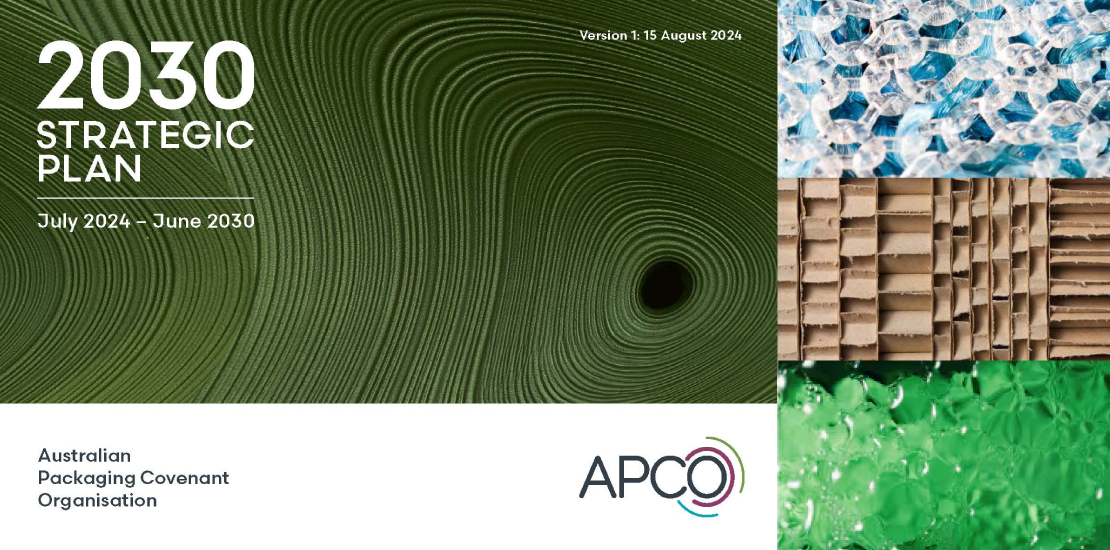Australian Packaging Covenant Organisation 2030 strategic plan – a shift in thinking and approach
- 2024-09-03
- Posted by: ANZRP Team
- Category: ANZRP

Why is there change on the horizon?
The Australian Packaging Covenant Organisation (APCO) has unveiled its 2030 Strategic Plan and blueprint for advancing stewardship of packaging in Australia. The changes come amidst a realisation that the 2025 targets will not be met and the ministerial expectation that industry needs to respond proactively going forward. There is widespread recognition that the “business as usual” approach might bring incremental improvements, but it will not fulfill key targets within the expected timeframes. This sentiment was clearly expressed by APCO’s CEO, Chris Foley, who said “We know that our members have made great strides in improving the recyclability of packaging and genuinely want to see our recycling rates improve. But the analysis is clear: we need to take a more hands-on approach to recycling if we’re going to see the results that the community expects.”
What are the aims of the national packaging covenant and its targets and how are we tracking?
The packaging covenant has two broad goals to reduce the environmental impacts of consumer packaging These are to support the:
- optimisation of resource recovery of consumer packaging; and
- prevent the impacts of littering
In line with this APCO established the following targets, to be met by the end of 2025:
- 100% reusable, recyclable or compostable packaging.
- 70% of plastic packaging being recycled or composted.
- 50% of average recycled content included in packaging.
- The phase out of problematic and unnecessary single-use plastics packaging.
The figure below shows the performance against the first three listed targets:
Whilst the targets have only been tracked to 2021-22 it is evident that the 2025 targets will not be met.
Agreement on packaging reform
Due to concerns that packaging stewardship goals and targets may not be met, stakeholders throughout the supply chain, spearheaded by APCO, have decided to question the current approach and create a new strategy to achieve ambitious national packaging targets. The proposed pathway is supported by a wide range of industry players across the supply chain and has been developed in consultation with Federal and State governments.
In line with this environment ministers from the various jurisdictions have agreed to reform the packaging regulation. The future framework will include:
- mandatory design standards
- recycled content requirements; and
- address the use of chemicals of concern.
The framework will be established under Commonwealth law and regulated by the Federal government, taking away the responsibilities previously managed by the States. This will provide for a more uniform and harmonised approach. The Federal government will also work with APCO to manage the transition.
What is the future approach?
Following a thorough analysis and member consultation process, APCO has resolved to adopt a more robust ‘whole of system approach” recognising that success needs to be built on the four following factors:
- that action throughout the value chain is vital
- the solution will depend on closing the economic gaps
- that all brand owners must take responsibility on an equitable and efficient basis
- the efficiency that a single administrator brings to the Covenant is highly valued by the members.
In line with this, from financial year 2027 APCO’s fees will move to be based on the types and volumes of packaging brands place on the market, with higher fees paid for materials that are more costly to recover, recycle and/or dispose. Under this system, commonly referred to as “eco-modulation” there will be drivers that incentivise brand owners to eliminate and reduce packaging, adopt reuse models, and transition to materials and formats that are easier to recycle. Importantly, funds raised through the new fee model will be invested in the downstream system to overcome economic barriers that have hindered progress towards national packaging targets.
The funds will be directed to supporting end markets, building reprocessing infrastructure and strengthening collection networks.
Highlights of the 2030 Strategic Plan:
APCO has summarised the highlights of the new strategic plan as being:
- Increased recycling: direct support for high-quality collection, recycling and packaging stewardship activities that, additional to business-as-usual, will enable the achievement of recycling targets and the production of high-quality Australian recycled content.
- New membership fee model: following modelling and targeted consultation, APCO member fees will be calculated using eco-modulation (ecological modulation). This will be based on each member’s packaging profile and incentivises the design of packaging for reduction, reuse, and recovery. The aim is for these to be in place in the financial year 2026-27.
- New indicators: The goals of the Covenant will be tracked using new indicators in addition to the existing targets, including the reduction of materials sent to landfill. By 2030, this reduction target is set at 1 million tonnes.
- Social license: the plan ensures that brand owners will have a supportive system that allows community expectations on packaging design and disposal to be met.
What is next and how can APCO members get involved?
APCO members are invited to join the 2030 Strategic Plan Member Reference Group which aims to:
- Test the proposed eco-modulated fee model
- Ensure APCO understands different member business models
- Understand barriers to effective reporting
The above scope of works will be undertaken between September 2024 and January 2025. Interested members should contact APCO by email – governmentpartnerships@apco.org.au
For more information: